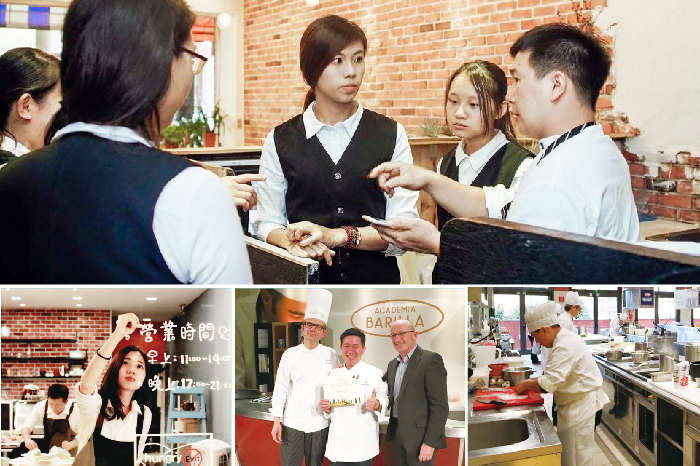一塊雞排的廚師人生| 藍廚義式廚房
文/黃書萍 照片提供/藍廚
04 723 2579 FB: 藍廚義式廚房 (暫時歇業)
彰化市實踐路42號 No.42, Shijian Rd., Changhua City 500, Taiwan
『用義大利的熱情,烹調台灣人情味』從不懂得吃、不懂得做,
到回看自己的土地,坐上屬於台灣人的餐桌,
這一路走來花了十年的功夫看自己做的事、吃自己做的菜。



一塊雞排的廚師人生
如果人生可以倒帶,年輕的我或許從來沒想過會踏上「廚師」的生活,回想開店前,從國中後就跟著朋友在街頭玩樂,一直到24歲決定回家照顧爺爺、奶奶,就這樣的轉念也就開啟了人生第一攤的雞排車。
當年第一次賣雞排是位於彰化市彰草路的區域,一開始就想做有別於胡椒、辣粉的口味,以水果結合優格推出草莓優格、藍莓優格的沾醬,雖然生意還不錯,但總是想這不是自己真正想做的事,因此毅然決然收了攤車。
在台式義大利麵中 發現義大利
第一代藍廚餐廳在2007年開幕,當時彰化的簡餐店、義大利麵店都不多,因此憑著自己在義大利餐館當過學徒的經驗就開店了,起初店內餐點包含義大利麵、火鍋、飯類…非常能滿足顧客需求,但當時並不曉得自己的料理有什麼好或壞,生意好時就維持菜單,市場風向改了就轉向,因此店內也曾出現蜜糖吐司、鬆餅…等熱銷餐點。
然而,這樣的狀況維持好多年,直到有一天朋友這樣問我:「你賣義大利麵,你去過義大利嗎?」當時的自己就像從夢中被搖醒,關於義大利我知道多少,改變菜單、改裝潢,自己不斷追逐的到底是什麼,就在那時候開始大量收集義大利食譜、文化、歷史書籍,也開始參加各種義大利料理廚師示範課程,為自己做功課尋找什麼是義大利料理。
在感官中重新打開料理精神
在經營藍廚以前從沒想過一位專業廚師該具備的條件,然而2015年偶然與「感官之旅甜點店」合作甜點寄售,因為這個合作也開啟自己去認識食物的層次,在這期間感官之旅的甜點師傅常跟我分享,一個甜點的製作到呈現,顧客從接收到甜點的瞬間,就啟動眼、口、舌、鼻人類天生的味蕾來回應這款蛋糕的滋味,經由一次次的討論、品嘗讓原本只是吃的動作,看到更多對食物層次的感官分析。看著感官之旅的甜點師傅自然顯露的自信,與對料理的熱情,讓我漸漸了解追尋料理的精神,或許不再只是食譜上的料理程序,背後有更精彩的故事。
就這樣,2016年我參加義大利C.P.I.C 義大利廚師認證考試,考試的範圍包含學科、術科,學科需要知曉義大利的地理、歷史、人文,術科是烹煮義大利料理(包含前菜、開胃菜、主餐、甜點),在那段準備到考試的過程我也發現,義大利人對純正義大利料理有著無比堅定的堅持,例如:「北義carbonara」這道來自北義大利的料理,當時在礦坑工作的工人都會於礦坑區用中餐,因此他們會在礦坑倒掛豬肉讓它自然風乾(也就是現在常見的培根),那工作時再帶上義大利麵條、雞蛋、起司、橄欖油,中午時就在礦坑煮上一份carbonara,就是這道料理純正的風味。就是這樣尊重自然條件,與對傳統食譜的堅持,義大利人非常了解每道料理的原味與精神,就如同瑪格麗特披薩就不該加上海鮮、一套完整義大利料理就不該畜牧與海鮮料理混雜…等等,都是義大利料理的精神。
從產地到餐桌 料理食材也料理自己
在義大利與義大利料理之間我漸漸明白「從產地到餐桌」,料理的精神要先回看產地的自然產出,食材的處理方式也各有道理,更重要的是料理的過程那些看不見的細節,就如:煮義大利麵在撈起前加上白酒,是讓麵條與佐料拌炒結合前提味的功能,如此細節的功夫雖然上菜時看不到,卻是味蕾可咀嚼出的層次,這也是這麼多年來廚房的工作不斷提醒自己,廚師雖然磨練的是手上功夫,呈現的卻是做人的態度。
訪談後記
訪談的過程中,葉大哥不斷提及『用義大利的熱情,烹調台灣人情味』,從不懂得吃、不懂得做,到回看自己的土地,坐上屬於台灣人的餐桌,這一路走來花了十年的功夫看自己做的事、吃自己做的菜,我想這一句話也是花了十年才走到此,走進藍廚不僅是飽餐一頓,遇上老闆聊聊屬於他的烹調課。

A culinary journey started from fried chicken fillets
Interviewee/ Chef Yeh Jia-Hsiang, Blue Cook Italian Restaurant Interviewer and Editor/ Daniella
Looking back, I had never thought about becoming a chef. I had been fooling around in the streets with friends since junior high school. At the age of 24, I decided to return home to look after my grandparents. It was then I had a change of mind and started my first business with a fried chicken fillet cart.
I started selling fried chicken fillet on Zhangcao Road in downtown Changhua. Intended to make a distinction from common flavors of fried chicken fillet like pepper and chilly, I invented a dipping sauce based the combination of fruit and yogurt. Business was good, but I figured it was not what I truly wanted, so I wrapped it up and quit.
Learning about Italian tastes in Taiwanese spaghetti
Blue Cook 1.0 was opened in 2007. Back then, there weren’t many diners or spaghetti specialty restaurants. I opened a spaghetti restaurant based on my experience serving as an apprentice in an Italian restaurant. At first, I served whatever dishes that appealed to the customers. I did not distinguish good and bad in what I serve. When the business was good, I kept the menu. When the market demanded something else, I followed the trend. So, there were times when customers could get honey toasts and waffles in my restaurant.
I followed the business model for several years until one day, a friend asked, “You sell spaghetti. Have you been to Italy?” The question got me thinking, how much did I know about Italy? What was I seeking with all the change of menus and interior decor? I then started gathering Italian recipes, reading about Italian culture and history. I also took Italian cooking lessons. It was my endeavor to trace the root of Italian cuisines.
Rebooting my cooking spirit in senses
Before Blue Cook, it had never occurred to me what a professional cook should be equipped with. In 2015, I stumbled across a partnership with Bon Voyage Pâtisserie to sell its desserts in my restaurant. The collaboration introduced me to the layers of food. The pâtissier of Bon Voyage Pâtisserie often shared with me the process of dessert making. Essentially, the moment a dessert is presented to a customer, flavors and tastes are being received via the eye, mouth, tongue and nose. Through rounds and rounds of discussions and in-depth tasting, the act of eating has evolved into a sensational analysis about the different layers of the food. Enlightened by the confidence and passion of the pâtissier of Bon Voyage Pâtisserie, I started to pursue the essence of cuisines. A dish can be more than just the executional result of a series of procedures in the kitchen. Rather, a dish can encompass a wonderful story.
With the notion, I took the Certification of Proficiency in Italian Cuisine (C.P.I.C) in 2016. The exam for the certification covers academic knowledge on Italy’s geography, history and culture, and the actual practice of cooking Italian dishes which include starter, appetizer, main course and dessert. I acquired the sheer consistency of authentic Italian cuisines. For instance, spaghetti carbonara is a northern Italian dish made with egg, olive oil, cheese and pork. As Italian miners would normally have lunch in the mines, they hung pork in the mine to have it naturally dried (It is the making of bacon.) They would make lunch with ingredients they brought to work along with the bacon in the mine, and the dish is called carbonara. The respect Italians show towards natural settings and traditional recipes cannot be overemphasized in authentic Italian food. Italians value the original flavor and essence of every dish, so this is why a Pizza Margherita cannot be topped with seafood, and a comprehensive Italian menu can never tolerate the mixture of poultry and seafood.
From place of production to dining table, I am making food and also making sense of myself
Gradually, I got a grasp of Italian cooks’ emphasis, “from place of production to dining table”. The essence of cooking can always be traced back to where the food comes from. How certain food ingredients are to be processed also abides by specific principles. More importantly, there are a bunch of details tucked away in the making of a dish. For example, white wine is poured over boiled spaghetti to prepare the spaghetti for better mixture with the condiment. The presence of white wine itself may not be observed in the final presentation of the dish, but it allows the taste buds to pick up more of culinary intricacy. This is what I constantly remind myself of in the kitchen for all these years. Chef is to sharpen culinary skills in order to present an attitude.
Notes to the interview
During the interview, Chef Yeh repetitively mentioned “cooking Taiwanese flavors with Italian passion”. Evolving from a person who knew little about cooking to a chef now reflects his mother land on the dining table dedicated to Taiwanese people, it took him ten years to arrive at this point, reviewing what he is doing and what he is presenting on the plate. I suppose “cooking Taiwanese flavors with Italian passion” is a summary of his ten-year culinary journey. A meal at Blue Cook is not just to fill up your empty stomach, but a chance to hear about Chef Yeh’s lessons learned in the kitchen.




